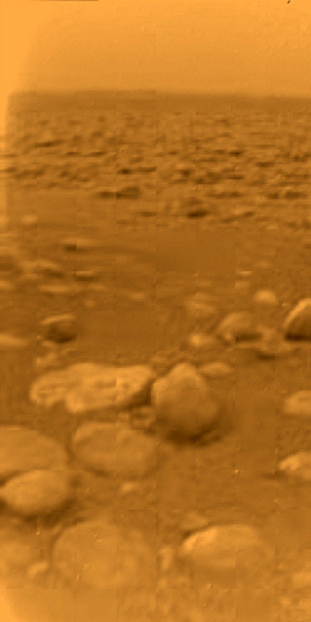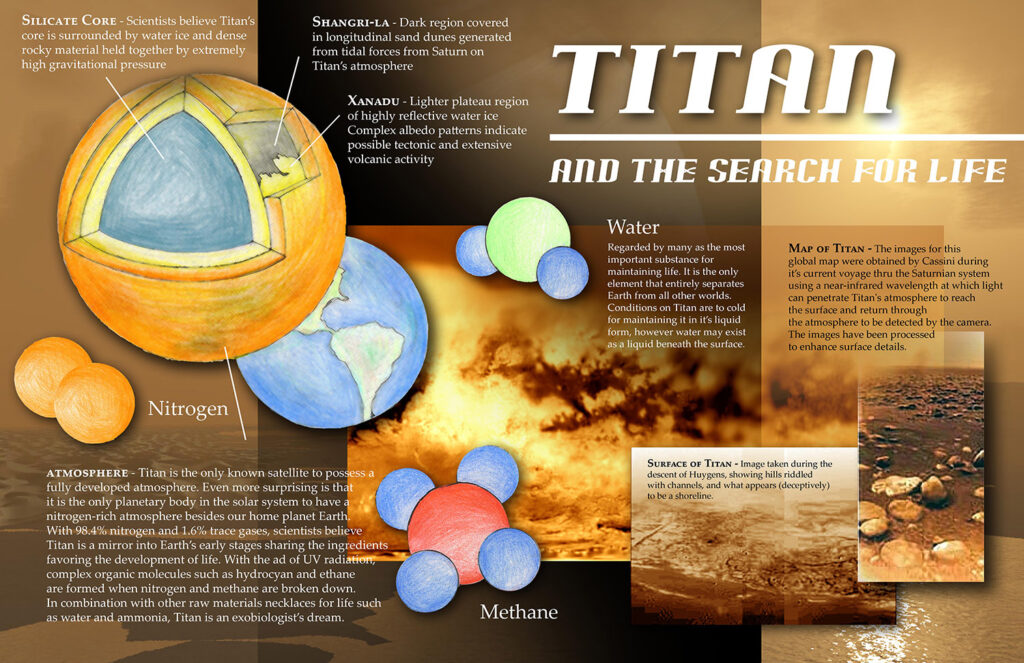
Titan is a cold, icy world surrounded by a thick, hazy, orange atmosphere. Standing on its surface would resemble standing on the planet Vagra II of Star Trek TNG. Although there’s more than likely no black gue serving as the embodiment of evil oozing about its surface, it’s also unique in that it is the only place we know of other than Earth to have bodies of surface liquid on its surface.
We’ve had a long history of observing Titan.
Most of our telescopes perceive it as a fuzzy orange ball of light, near Saturn, however, multiple missions have given us new insight into this beautiful world and why it makes for an intriguing destination for interplanetary discovery, even more so than Mars.
Since its discovery in 1655, Titan has been visited by Pioneer 11 in 1973, Voyager 1 in 1980, Voyager 2 in 1981, and the Cassini in 2004.
Cassini–Huygens mission, launched by NASA, but built and operated by the ESA, the European Space Agency, collected valuable information about Titan during the Cassini probe’s nine-year orbit of Saturn and the successful landing of the Huygens space probe on Titan’s surface in 2005.
During the mission, planetary scientists mapped the moon’s surface and had the Huygen’s space probe transmit images back to Earth, including the famous “in situ” image of Titan’s surface.

NASA’s scheduled 2027 mission, Dragonfly, plans to send a rotorcraft or small helicopter to land on Titan and assess its methane oceans, chemically complex atmosphere, propensity for microbial life, and prebiotic chemistry while performing vertical takeoffs and landings between multiple locations sampling diverse geological regions.
We stand to learn a lot from Titan.
Although I’m a fan of more unmanned missions to Titan, looking into this world has inspired me to list my five reasons why Saturn’s largest moon is the best place for us to get the most bang out of our dollars when it comes manned, Elon Musk style, interplanetary travel.
1. Titan’s Atmospheric Pressure is Just Right
Although our solar system has over 150+ moons, Titan is the only moon with a dense atmosphere equivalent to swimming around 50 feet (15 meters) below the surface of an ocean on Earth with a height of 370 miles (600 kilometers) above the planet’s surface, ten times higher than Earth’s.
It is estimated that the air pressure near the moon’s surface is around 1.5 denser than the air pressure of Earth’s atmosphere. This fact alleviates the major air pressure problem the movies underrepresent. One of the significant jobs of space suits and airlocks is to stabilize the air pressure around our bodies.
If the air pressure isn’t stabilized, astronauts risk getting “the bends” or, horrifically stated, the fluids in your body boil with extreme changes in air pressure. Air pressure of 1.5 wouldn’t be much of a difference for us and would prevent us from having to pressurize bulky EVA spacesuits. Airlocks wouldn’t have to work as hard, significantly cutting down our prep time for spacewalks. I dont know about you, but I hate prep time.
2. It’s Protected from Deadly Radiation
Titan’s atmosphere would also protect us from deadly radiation in the form of particles from the Sun and galactic cosmic rays. This is the most understated peril of space exploration since significant radiation exposure can cause cancer and cognitive disorders.
We take the protection we receive from our atmosphere and the Van Allen radiation belts within Earth’s magnetosphere for granted. NASA limits astronauts’ in Low Earth Orbit to around 200 days. Titan’s atmosphere prevents many of these particles from reaching the surface. While Titan doesn’t have a magnetosphere, two factors add to the protection it could provide. The moon spends 95% of its time within Saturn’s magnetosphere. Titan also has an “induced magnetosphere,” which could give a little more protection from deadly radiation.
3. Movement on Titan Would Effortless
A thick atmosphere and low gravity would make traveling on the moon easy and fun. I’m speculating here, but it may even be possible to fly with artificial wings. Think about it. Titan’s surface gravity is 1.352 meters/second squared, 14% of Earth’s gravity, a little less than our moon. Air is required for flight, and Titan’s atmosphere is five times thicker than air here on Earth, perfect for sustained elevation.
4. Titan Has Abundant Energy Sources
Let’s not forget that Titan’s lakes, and seas are composed of liquid methane and ethane, hydrocarbons that could serve as energy sources. Natural gas here on Earth is predominantly composed of methane, one of the abundant gases on Titan. If you haven’t noticed yet, carbon and carbon molecules are at the center of almost all conversations involving life and energy, including sugar, calories, carbs, proteins, amino acids, DNA, genes, fossil fuels, natural gas, or oil, and the greenhouse effect.
Even though it is not clear whether Titan can support life, its climate, geological development, and chemical composition make it one of the best places in the solar system to look for signs of life. Researchers believe Titan is analogous to Earth’s early years.
Before starting the “there could be life” talk, it’s important to remember that life on Titan is improbable but never zero.
Life, as we know it here on Earth, is water-based. Titan averages a temperature of -290 F° which is well below the freezing point of water. These cool temperatures also aren’t conducive to the metabolic processes of life. Sad story, but what is all of this talk of life?
5. Titan Could Provide Answers as to the Origin of Life
Two angles animate the correlation between life and Titan.
First, Titan’s chemical composition closely resembles what scientists believe prehistoric Earth looked like. Therefore studying this environment promises to make headway in learning how life formed on Earth.
Second, theoretically, life could exist on Titan in much the same way life exists in oxygen-deprived environments around deep-sea hydrothermal vents. However, in Titan’s case, this life would use hydrogen instead of oxygen and replace water with a liquid hydrocarbon such as methane and ethane.
Here’s also an excellent opportunity to discuss “tholins” and how they relate to exoplanetary biology.
Tholins are at the center of why scientists are so thrilled about the prospect of life on Titan. Titan’s orange, hazy color comes from the suspension of “tholins” in the Titanian atmosphere.

The term was coined by Carl Sagan in collaboration with Bishun Khare when they conducted Miller–Urey experiments, or experiments taking mixtures of gases commonly found throughout our Solar System and irradiating them. (Exposing them to naturally occurring radiation such as UV rays). These experiments produced a brown, sometimes sticky, gooey residue; hence Sagan and Khare gave it the name “tholin,” derived from the Greek word tholos, meaning “mud” or “muddy.”
In laymen’s terms, tholins are organic compounds formed by solar ultraviolet or cosmic ray irradiation of carbon-based molecules and compounds such as carbon dioxide, methane, ethane with nitrogen, and water. They exhibit an orange-brown color and consist primarily of carbon, nitrogen, and hydrogen.
In the lowlands, tholins, which are a class of carbon-rich molecules, fall from the haze onto its surface, where they form massive dune fields that cover the entire surface. The discovery that liquid methane and ethane can replace water as an energy source raises the possibility that these tholins could serve life’s foundation.
We’ll cover the specifics of visiting our Moon and Mars in future articles, but first, we wanted to make sure Titan is a part of this discussion.
Love of Space and space exploration? Check the links below. References for this article are also listed below.
- Life on Titan — Poster illustrating aspects of the search for life on Titan and key features of the moon.
- The Solar Republic Card Game — The Solar Republic Card game is a game based on the Sun, planets, and moons of our Solar System. These celestial bodies are represented as astronomical symbols on each card within a deck with many similarities to the standard 52 card deck of playing cards.
- The Solar Republic Store — features the card game as well as other space-related merchandise such as cool posters, mugs, and athletic gear.
- The Solar Republic Facebook Page
- The Solar Republic Instagram Page
References:
Titan is better than Mars for human colonization
Confession Of A Planetary Scientist: ‘I Do Not Want To Live On Mars’
Titan’s induced magnetosphere
What in the world(s) are tholins?
NASA In-Depth: Titan
Quincy Bingham is a native Mississippian, world traveler, and digital marketing director. Although his bread and butter is digital marketing, his crowning achievement has been the Solar Republic brand, which embodies his values of kaizen, personal development, and lifestyle design. He has learned through professional and personal experience that change is the only constant in life, trust is the only real currency and consistency is the only vehicle that gets you to where you want to be in life.
He currently resides in Chicago, IL where he assists businesses, agencies, and non-profits grow their organizations with digital marketing and growth hacking principles.



